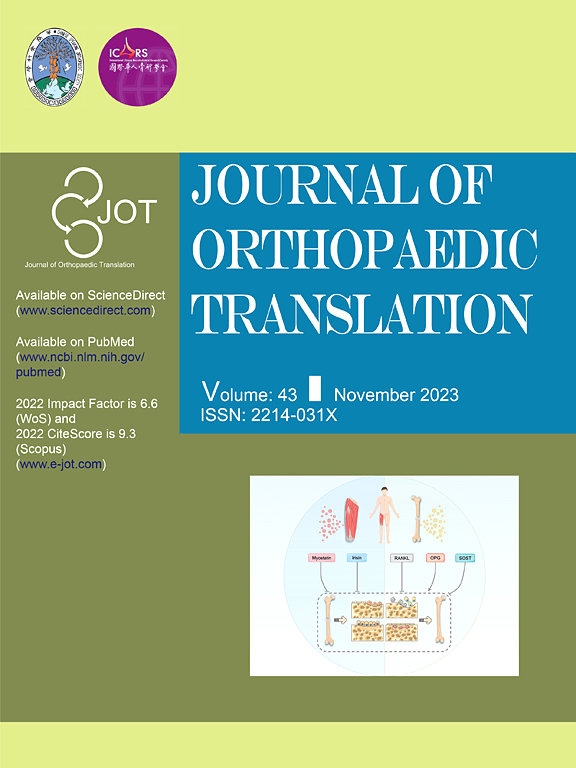PPARγ控制escrt依赖的成纤维细胞样滑膜细胞外泌体的生物发生并减轻由外泌体ANXA1介导的软骨细胞骨关节炎
IF 5.9
1区 医学
Q1 ORTHOPEDICS
引用次数: 0
摘要
背景:运动疗法已被公认为治疗骨关节炎(OA)的一线疗法。参与成纤维细胞样滑膜细胞(FLSs)和软骨细胞之间相互作用的运动相关外泌体可能是治疗OA的一种新的纳米颗粒策略。方法采用单细胞转录组测序法对运动治疗相关基因进行研究。用携带低表达或过表达序列的重组腺病毒转染细胞。通过数据独立获取的fls衍生外泌体的定量蛋白质组学用于研究外泌体货物。结果在本研究中,运动刺激下FLSs中PPARγ表达上调。我们的数据显示,过度表达(OE) PPARγ FLSs衍生的外泌体可以改善体内OA的严重程度,激活自噬,抑制软骨细胞凋亡,减少软骨退变。而敲低(KD) PPARγ FLSs衍生外泌体加重OA。此外,我们发现PPARγ控制转运(ESCRT)依赖途径激活外泌体生物发生所需的内体分选复合体。膜联蛋白A1 (ANXA1)在OE- PPARγ外泌体中富集。外泌体标记实验证实FLSs外泌体ANXA1可被软骨细胞内化,ANXA1可抑制ERK磷酸化,激活自噬,减少软骨细胞凋亡。结论spparγ控制escrt依赖性FLSs外泌体的生物发生,减轻外泌体货物ANXA1蛋白介导的软骨细胞骨关节炎。本文ppar γ/ESCRT - FLSs外泌体ANXA1 - ERK轴的转化潜力为OA的运动治疗提供了更深入的理论基础,为临床将纳米颗粒转化为OA治疗提供了新思路。本文章由计算机程序翻译,如有差异,请以英文原文为准。

PPARγ controls ESCRT-dependent fibroblast-like synoviocyte exosome biogenesis and alleviates chondrocyte osteoarthritis mediated by exosomal ANXA1
Background
Exercise therapy has been recognized as first line therapy of osteoarthritis (OA). The exercise related exosome involved in the interaction between fibroblast-like synoviocytes (FLSs) and chondrocytes could be a novel nanoparticle strategy for treating OA.
Methods
Single-cell transcriptome sequencing was used to investigate the exercise therapy-related gene. Cells were transfected by recombinant adenovirus carrying knockdown or overexpression sequences. Quantitative proteomics of FLS-derived exosomes via data-independent acquisition was used to investigate exosomal cargo.
Results
In this study, PPARγ was upregulated in FLSs under exercise stimulation. Our data revealed that overexpression (OE) PPARγ FLSs derived exosome could ameliorate the OA severity in vivo and activate autophagy, inhibit chondrocyte apoptosis, and reduced cartilage degeneration. But knockdown (KD) PPARγ FLSs derived exosome aggravate the OA. Moreover, we found PPARγ controls the endosomal sorting complex required for the transport (ESCRT)-dependent pathway to activate exosome biogenesis. Annexin A1 (ANXA1) was enriched in OE- PPARγ exosome. As a therapeutic cargo, FLSs exosomal ANXA1 was confirmed be internalization by chondrocyte via exosome labeled experiment and ANXA1 could inhibit the phosphorylation of ERK to activate the autophagy and decrease chondrocyte apoptosis.
Conclusions
PPARγ controls ESCRT-dependent FLSs exosome biogenesis and alleviates chondrocyte osteoarthritis mediated by exosomal cargo ANXA1 protein.
The translational potential of this article
PPARγ/ESCRT – FLSs exosomal ANXA1 – ERK axis provides a deeper theoretical basis for exercise therapy of OA and a new idea for the clinical transformation of nanoparticles into OA therapy.
求助全文
通过发布文献求助,成功后即可免费获取论文全文。
去求助
来源期刊

Journal of Orthopaedic Translation
Medicine-Orthopedics and Sports Medicine
CiteScore
11.80
自引率
13.60%
发文量
91
审稿时长
29 days
期刊介绍:
The Journal of Orthopaedic Translation (JOT) is the official peer-reviewed, open access journal of the Chinese Speaking Orthopaedic Society (CSOS) and the International Chinese Musculoskeletal Research Society (ICMRS). It is published quarterly, in January, April, July and October, by Elsevier.
 求助内容:
求助内容: 应助结果提醒方式:
应助结果提醒方式:


